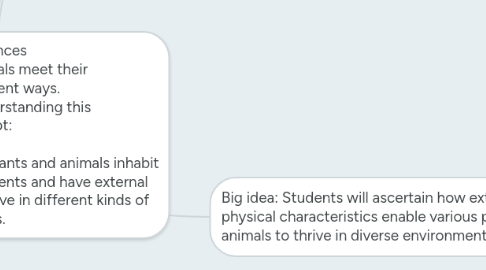
1. Big idea: Students will ascertain how external physical characteristics enable various plants and animals to thrive in diverse environments.
1.1. Learning objective 1: Understand that plants and animals live in different habitats: Students are able to accurately position plants and animals in appropriate layers of the rainforest.
1.1.1. Scaffolding Strategy 1
1.1.1.1. Visuals and Realia
1.1.1.1.1. Students at the first grade level are highly visual and benefit from connections made through language and visual media. The more they can see something, the clearer it becomes to them.
1.1.2. Scaffolding Strategy 2
1.1.2.1. Connect to Background Knowledge
1.1.2.1.1. Our rainforest unit is centered around connections to our prior learning. In fact, this unit is a way of building on what we have learned by applying it in a real world situation.
1.2. Learning objective 2: Know that animals present different colors and sizes that help them live in different places: Students are able to identify animals, especially those features (colors, parts) that enable them to thrive in particular ecosystems.
1.2.1. Scaffolding Strategy 1
1.2.1.1. Read Aloud
1.2.1.1.1. A good way to introduce topics is to read passages from texts.
1.2.2. Scaffolding Strategy 2
1.2.2.1. Visuals
1.2.2.1.1. Pictures are vital to young learners, as previously mentioned.
1.3. Learning objective 3: Know that specific features of animals help them to move in different ways: Students are able to identify and describe features of animals that enable them to move in different ways. Students are able to explain how those ways of moving allow animals to live best in certain layers of the rainforest?
1.3.1. Scaffolding Strategy 1
1.3.1.1. Sentence Starters
1.3.1.1.1. It's helpful to first graders to start them out by asking things like:
1.3.2. Scaffolding Strategy 2
1.3.2.1. Vocabulary Review
1.3.2.1.1. At the beginning of the class, teachers can go through the relevant vocabulary for the day.

